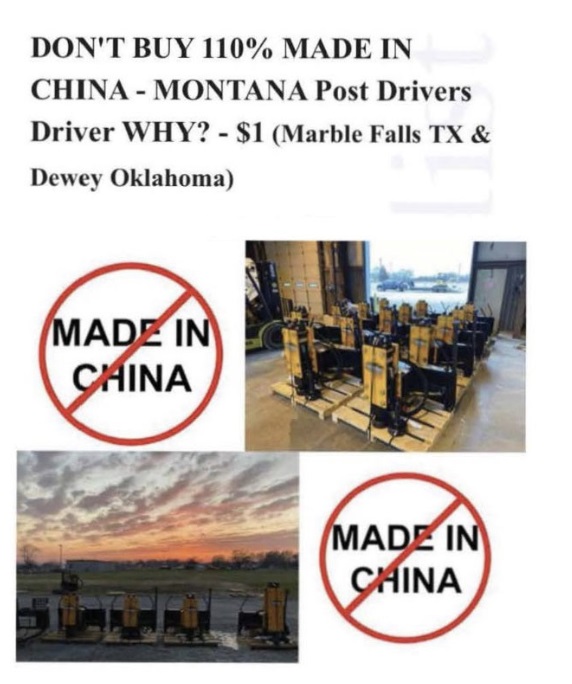I Dig Texas (IDT) and Creager Services (Creager) are competitors that sell attachments for skid steer loaders, a type of heavy machinery that resembles Scoop from Bob the Builder. To discourage the purchase of Creager's MONTANA-brand attachments and to promote the sale of its own, IDT ran ads that claimed that Creager's products are "110%" made in China," in contrast to its own that are made in America. Accompanying this mathematically implausible claim, IDT included (without permission) two photos depicting Creager's products to, as the court put it, "underscore their connection to China." This is the ad:

Creager sued for (1) copyright infringement, based on the unauthorized use of its photos in the ad and (2) false advertising, on the grounds that the claim that IDT's products were made in America was false since certain components were sourced from outside the country. Jeff covered the false advertising claims in this post. I will focus on the copyright claim.
In the district court, IDT moved for summary judgment, arguing that its use of the photos qualified for fair use. The district court agreed, finding that, on balance, the statutory factors (17 U.S.C. § 107) weighed in favor of fair use:
- The first factor (nature and purpose and character of the use) favored a finding of fair use because the photos were used for comparative advertising purposes;
- The second factor (the nature of the copyrighted work) was neutral because it was unlikely that "creative judgement played a substantial role in the creation of the images" since they merely depicted Creager's products;
- The third factor (the amount and substantiality of the portion used) weighed against fair use since the photos were used in their entirety; and
- The fourth factor (effect on the market) weighed in favor of fair use since Creager presented no evidence that a marketplace existed for its photos.
On appeal, the Tenth Circuit ignored the district court's fair use analysis and affirmed on the alternate grounds that Creager had failed to offer evidence to support that any of IDT's profits were attributable to the infringing use of the photos in the ad. The district court had ruled shortly before SCOTUS issued its opinion in Andy Warhol Foundation v. Goldsmith. Did the appellate court harbor doubts about the soundness of the district court's fair use analysis in the wake of Andy Warhol Foundation? Perhaps. See this post and this one.)
Section 504 of the Copyright Act permits a copyright owner to recover the actual damages suffered as a result of the infringement, as well as "any profits of the infringer that are attributable to the infringement and are not taken into account in computing the actual damages" (emphasis added). In many circumstances, determining whether an infringer's profits are "attributable to the infringement" is straightforward. For example, if an infringer copies and sells the plaintiff's copyrighted work in its entirety (e.g., a vendor on Canal Street who sells pirated copies of movie screenplays), then it is clear that the infringer's profits were attributable to the infringement. (Those are categorized as direct profits.) However, when (like in this case) the copyrighted work is used without permission to advertise goods, but is not incorporated in the goods themselves, measuring whether, and to what extent, the profits earned from the sale of those goods are "attributable to the infringement" can be challenging. (Those are categorized as indirect profits.) We have written about those challenges before in this post.
[An aside: the court's opinion doesn't explain why Creager didn't seek actual damages (such as the amount of a licensing fee to use the photos) but instead limited its claim to IDT's profits. Perhaps Creager feared that any actual damages would be nominal, given the mundane nature of the photographs at issue?]
When seeking indirect profits, the copyright owner bears the initial burden of demonstrating that there is a causal nexus between the infringement and the defendant's profits. Here, the appellate court found that Creager had failed to proffer any evidence to support that such a nexus existed. As the court explained:
"Creager presented no evidence that I Dig Texas had made any money from the advertisements bearing the copyrighted images; Creager showed only that I Dig Texas had included copyrighted images in its advertising. But Creager didn't present evidence that anyone had bought something from I Dig Texas because of these advertisements. And even if someone had bought something from I Dig Texas based on these advertisements, there's no reason to believe that the two photographs would have made a difference to any consumers."
The result here is not a huge surprise. While it is not difficult to imagine that some customers seeing the ad might have been motivated to purchase IDT's products because they are "Made in the USA" (which, after all, was the main communication in this ad), it is harder to believe (and difficult to prove) that the inclusion of two unremarkable photos of Creager's products would have had much of an impact on the customers' purchasing decisions. To succeed on this type of indirect profit damage theory, a plaintiff must offer more. See, e.g., Laspata DeCaro Studio Corporation v. Rimowa GMBH.
I Dig Texas, LLC v. Creager, 98 F.4th 998 (10th Cir. April 12, 2024)
This alert provides general coverage of its subject area. We provide it with the understanding that Frankfurt Kurnit Klein & Selz is not engaged herein in rendering legal advice, and shall not be liable for any damages resulting from any error, inaccuracy, or omission. Our attorneys practice law only in jurisdictions in which they are properly authorized to do so. We do not seek to represent clients in other jurisdictions.

